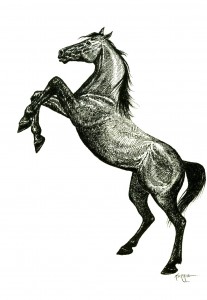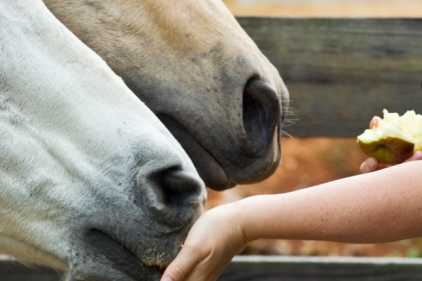 This is one of my horse drawings I found in an old journal of mine. A bunch of my artwork was destroyed when stored in our basement that flooded last spring. I had forgotten that my drawings were down there! So it was neat to find this drawing, forgotten but still in good shape.
This is one of my horse drawings I found in an old journal of mine. A bunch of my artwork was destroyed when stored in our basement that flooded last spring. I had forgotten that my drawings were down there! So it was neat to find this drawing, forgotten but still in good shape.
A trainer friend of mine, Kevin Wescott, wrote a great article for Liverystable.net entitled What Is The Best Way to Stop a Rearing Horse?. I wanted to share an excerpt of that article here:
When you have a young horse, the horse is going to check you out to see what you know. If he finds out that some things you ask you don’t follow through with, he may begin to think you can’t make him do it. Such as, you ask him to trot and he doesn’t trot, and you don’t make him, and he begins thinking that you cannot make him trot. It may get worse then, such as the horse thinking you can’t make him move. And he may go up in a rear rather than go anywhere. Or he may not obey you asking him to turn once, and may take advantage of that situation and next time refuse to turn. Why would he want to obey a person when he could just do his own thing? In this way, the horse may learn to always take advantage of that person, and it could become very dangerous, and you find yourself in a situation where you really need professional help, in training this horse through its issue of rearing or whatever its unwanted behaviour is.
A horse’s past history in training is very important, because how a horse is dealt with initially will form how it will react later on. A horse must be taught to move forward. If a horse begins to refuse to go forward, and learns to rear, go over, buck, or fall, he has learned to think of any action he can do to avoid going forward. It is a rider error that has caused this, and now a horse must be disciplined and worked through a problem that should have never been there. Just by overlooking a refusal or attitude that happened during its initial training, a bad habit is formed. Rearing is usually a learned training experience that the horse has developed.
For safety reasons, revert to groundwork. The horse MUST learn that it has to go forward when you ask it to, in spite of fear or unwillingness…just because you ask. There should be no hesitation, the horse should move forward immediately when asked. Any hesitation is going to spell trouble for you, because if the horse has the slightest idea that he doesn’t have to go, the end result is not going to be good. This is the best way to prevent and work through a rearing habit…the horse has to move forward when you ask it to.
Some groundwork lessons to work on would be trailer loading, or any spot where it is difficult for the horse to go, or where his reaction is to balk or not want to move forward of his own will. You should stand beside the horse, or in front if necessary… not behind him. You should be asking him to move forward with your leading hand and following with your driving hand. Find a place a little difficult but not dangerous, such as a trailer, through a barn door, etc. Have the horse go in ahead of you, you are not leading or driving behind, the horse should move in and respond to a signal from you as you are beside or in front of it. You r goal is to get the hesitation out of him, when the horse is given the cue to move forward, the horse does NOT hesitate to move forward smoothly when asked. You need to work on it until it is not jumpy or hesitant, but smooth, quiet, and immediate. The key is repetition.
A horse may have a “flashback” to a time when rearing helped him escape from something that frightened him, and when a scenario comes along that he doesn’t like, he will rear again. It may only be with the one rider who he has learned that this action results in him not having to go on through something, or face whatever it is he doesn’t like. The horse may never attempt it with another rider. But in the worst case scenario, a horse will have developed this rearing habit so that it rears with any rider. Most likely a young horse can be worked with a little bit, asking for forward movement, and the rearing problem will be completely solved.
Some of the tactics used to break a horse from rearing went out with the dinosaurs in the Flood…such as allowing the horse to rear up and pulling them sideways to make them fall. Other methods such as breaking a balloon full of warm water, or pouring a bottle of water over a horse’s head may be effective, but very dangerous for the rider to try to stay in the saddle while doing it. These tactics aren’t very safe or fool-proof. There are other things a trainer can try, but we would not advise the average rider to attempt them for safety reasons. These are things you might observe an experienced horse person do, but we cannot describe them easily in writing because the timing is crucial, the horse’s actions and reactions may be varied, and it is better to observe them in person rather than try to explain them in writing.
Again, I would suggest you find a trainer you trust and have them work with your mare, as rearing is such a dangerous habit.

